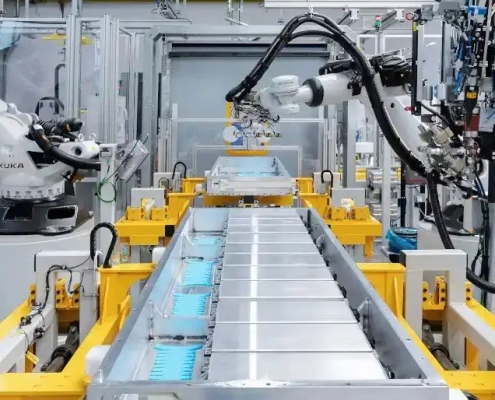How to Charge 12v Lithium Battery
Table of Contents
- How to Charge 12v Lithium Battery
- Understanding How Lithium-Ion Batteries Function
- What Defines a Battery Charger?
- Best Practices for Charging Lithium-Ion or LiFePO4 Batteries
- Using a Standard Battery Charger for a Lithium Battery—Is It Possible?
- Do You Need a 12V Lithium Battery Charger for Proper Charging?
- Can an AGM Charger Be Used to Recharge a Lithium Battery?
- Charging a Lithium-Ion Battery Without a Dedicated Charger—What to Know
- Lifespan of Rechargeable Batteries: How Long Can They Last?
- Which 12V Lithium Battery Charger is Best for LiFePO4 Batteries?
- Charging a Lithium Battery Using a Lead Acid Charger—Is It Feasible?
- Charging Profile: Sealed Lead Acid (SLA) Battery vs. 12V Lithium Battery
- LiFePO4 Battery Charging Profile—What Makes It Different?
- Key Characteristics of Charging a 12V Lithium Battery
- Adjusting Voltage and Current During 12V Lithium Battery Charging
- Why Lithium Batteries Are Replacing Sealed Lead Acid in Float Applications
- Guidelines for Long-Term Storage of Lithium Batteries
- Conclusion
- Learn More About Battery
To properly charge a 12v lithium battery, you need to use a dedicated 12v lithium battery charger that matches the battery’s specific voltage and current requirements. It is essential to avoid using chargers designed for other battery types, such as lead-acid, as they can damage lithium batteries. Whether using a lithium battery charger with Anderson plug or a built-in charger, understanding the right charging practices will help maintain your battery’s health and extend its lifespan. This chapter will guide you through the safe and efficient methods to charge a 12V lithium battery correctly.
Understanding How Lithium-Ion Batteries Function
Lithium-ion batteries are widely used in devices like smartphones, laptops, and even electric vehicles because they are lightweight and can deliver a high amount of power. Their unique design allows them to provide consistent power output through most of their discharge cycle. This is known as a “flat discharge curve.” Unlike lead-acid batteries, which gradually lose power as they discharge, lithium batteries maintain steady voltage, making them ideal for applications that require stable performance.
Key Components of Lithium-Ion Batteries:
- Lithium and Carbon Electrodes: The anode (negative electrode) is made of lithium, while the cathode (positive electrode) uses carbon. These materials help keep the battery lightweight and provide a high energy density.
- Electrolyte Solution: The electrolyte allows lithium ions to move between the anode and the cathode during charging and discharging.
- Separator: This layer prevents short circuits between the anode and cathode while allowing ions to pass through.
During charging, lithium ions move from the cathode to the anode, storing energy. When discharging, the ions move back, releasing energy to power the connected device.
LiFePO4 Battery: A Type of Lithium-Ion Battery
LiFePO4, or Lithium Iron Phosphate, is a subtype of lithium-ion battery with distinct advantages. It uses a different chemical composition, making it more stable and suitable for heavy-duty applications like home energy storage, boats, and RV systems. LiFePO4 batteries have the following benefits:
- Long Cycle Life: They can handle more charge and discharge cycles than standard lithium-ion batteries.
- High Temperature Performance: LiFePO4 cells can operate in hotter conditions without the risk of thermal runaway.
- Safety: They are less likely to overheat or catch fire, making them one of the safest lithium batteries available.
What Defines a Battery Charger?
A battery charger is a device that supplies electrical energy to a battery, restoring its capacity. A 12v lithium battery charger is specifically designed to meet the charging needs of a 12v lithium battery, ensuring the voltage and current settings are optimized for safety and performance. There are several types of chargers:
- Portable Chargers: Ideal for quick recharges on the go.
- Built-In System Chargers: These are integrated into RV or solar systems.
- Solar Chargers: Use solar panels and a charge controller to charge the battery.
Choosing the right type of charger is essential because using a non-compatible charger can damage a lithium battery.
Best Practices for Charging Lithium-Ion or LiFePO4 Batteries
To ensure the long-term health of a 12v lithium battery, it’s important to follow best practices:
- Use the Right Charger: Only use a 12v lithium battery charger that’s designed for lithium-ion or LiFePO4 batteries. Avoid using chargers made for lead-acid or AGM batteries, as they operate at different voltages and may overcharge or undercharge the lithium battery.
- Monitor Voltage and Current Levels: Lithium batteries have specific voltage and current ranges that should not be exceeded. A typical 12v lithium battery is fully charged at around 14.4V. Overcharging beyond this point can cause irreversible damage.
- Avoid Trickle Charging: Unlike lead-acid batteries, lithium batteries don’t need to be kept on a trickle charge. Leaving them on a charger for extended periods can degrade the battery over time.
- Keep Temperatures Stable: Lithium batteries perform best at moderate temperatures. Avoid charging in extremely hot or cold conditions to prevent damage.
- Charge Regularly: For LiFePO4 batteries, frequent shallow charges are better than infrequent deep discharges. This charging pattern will help extend the battery’s lifespan.
Using a Standard Battery Charger for a Lithium Battery—Is It Possible?
The short answer is no. A standard battery charger does not have the correct voltage and current settings for a lithium battery. When a 12v lithium battery charger is not used, several problems can occur:
- Undercharging: A standard charger might stop before reaching the full voltage needed for a lithium battery. This results in reduced capacity and shorter runtime.
- Overcharging: On the other hand, a standard charger may not shut off at the correct voltage, leading to overheating and potential damage.
Always use a 12v lithium battery charger designed for your battery type. These chargers have built-in safety features, such as temperature monitoring and automatic shutoff, that are essential for lithium batteries.
Do You Need a 12V Lithium Battery Charger for Proper Charging?
Yes, a 12v lithium battery charger is necessary for maintaining the health and performance of your battery. Lithium batteries have a lower internal resistance than lead-acid batteries, which means they can accept higher charging currents. While this allows for faster charging, it also means the charger must precisely control the voltage and current to prevent overheating.
A proper 12v lithium battery charger has the following features:
- Multi-Stage Charging: This includes constant current, constant voltage, and automatic shutoff stages that optimize the charge.
- Temperature Compensation: Adjusts the charging voltage based on the battery’s temperature, preventing overcharging in hot weather.
- Built-In Safety Mechanisms: Protects against short circuits, overheating, and reverse polarity connections.
Using the right charger will not only extend your battery’s lifespan but also ensure it delivers reliable performance throughout its life.
Can an AGM Charger Be Used to Recharge a Lithium Battery?
While AGM (Absorbent Glass Mat) chargers operate at a higher voltage than standard lead-acid chargers, they still aren’t suitable for lithium batteries. An AGM charger usually has a charging profile that peaks at around 14.7V, which is higher than what a lithium battery can safely handle over time.
Using an AGM charger can cause:
- Overheating: Extended use may lead to overheating, which can degrade the battery.
- Reduced Capacity: Over time, using the wrong charger can reduce the effective capacity of a lithium battery.
Always use a 12v lithium battery charger specifically designed for lithium batteries to avoid these issues.
Charging a Lithium-Ion Battery Without a Dedicated Charger—What to Know
In emergencies, you may need to charge a lithium battery without a dedicated charger. While this is not recommended for regular use, there are a few safe options:
- Using a Solar Panel with a Charge Controller: Connect the solar panel to a charge controller, then attach it to the battery. Ensure the voltage and current settings match the battery’s requirements.
- Using a Vehicle’s Alternator: While driving, you can use the vehicle’s alternator to charge a 12V lithium battery. However, monitor the voltage closely, as the alternator may not provide a precise charge.
- Using a DC Power Supply: Set the output voltage to 14.4V and limit the current. This method should only be used temporarily and under supervision.
While these methods can work in a pinch, investing in a proper 12v lithium battery charger is the safest and most effective way to charge your battery.
Lifespan of Rechargeable Batteries: How Long Can They Last?
The lifespan of a rechargeable battery, particularly a 12v lithium battery, is measured in terms of charge-discharge cycles. A charge-discharge cycle is one complete use of a battery from 100% to 0% and back to 100%. The number of cycles a battery can handle before its capacity starts to degrade is a key factor in determining its longevity.
Understanding Lithium Battery Lifespan
Lithium batteries are known for their long lifespan compared to other battery types like lead-acid or AGM. A high-quality 12v lithium battery can provide between 3,000 and 5,000 full cycles. If you use one full cycle per day, the battery could last anywhere from 8 to 13 years. By comparison, a lead-acid battery typically lasts for only 500 to 1,000 cycles, making lithium batteries a more cost-effective option in the long run.
Factors Affecting Battery Lifespan
- Depth of Discharge (DoD): Shallow discharges (e.g., 30% to 40%) are less stressful for a battery than deep discharges (e.g., 80% or more). Reducing the DoD can extend the number of cycles a battery can handle.
- Temperature: High temperatures can accelerate battery degradation. Lithium batteries perform best at moderate temperatures between 32°F and 77°F (0°C to 25°C).
- Charging Practices: Using a compatible 12v lithium battery charger with the correct voltage and current settings helps maintain the battery’s health.
By following best practices, you can significantly extend the lifespan of your 12v lithium battery, ensuring reliable performance for years.
Which 12V Lithium Battery Charger is Best for LiFePO4 Batteries?
Choosing the right 12v lithium battery charger is crucial for maximizing the performance and safety of your battery. Here are some features to look for:
- Automatic Shutoff: The charger should stop charging when the battery reaches its full voltage (typically 14.4V for a 12V lithium battery). This prevents overcharging and extends battery life.
- Multi-Stage Charging: A charger with multiple charging stages, including constant current and constant voltage stages, ensures a smooth and efficient charging process.
- Compatibility with LiFePO4 Batteries: Make sure the charger is designed specifically for lithium batteries and has a charging profile compatible with LiFePO4 chemistry.
- Built-In Safety Features: Look for features such as short-circuit protection, over-voltage protection, and thermal monitoring.
A well-designed 12v lithium battery charger will provide these features, making it a reliable option for keeping your battery in top condition.
Charging a Lithium Battery Using a Lead Acid Charger—Is It Feasible?
Using a lead-acid charger to charge a lithium battery is not recommended. The charging profiles for lead-acid and lithium batteries are different, and a standard lead-acid charger can cause damage to a lithium battery. Lead-acid chargers typically have a float stage that maintains a small current to keep the battery at 100% state of charge. However, lithium batteries don’t require a float charge, and exposing them to this constant current can overcharge them, reducing their lifespan.
Why It’s Not Ideal:
- Voltage Mismatch: Lead-acid chargers often operate at lower voltages, which can lead to undercharging of a lithium battery.
- Float Charging: As mentioned, float charging is unnecessary for lithium batteries and can be harmful over time.
- No Temperature Compensation: Lithium batteries need chargers with temperature compensation features to prevent overheating.
Instead of using a lead-acid charger, always opt for a 12v lithium battery charger designed specifically for lithium batteries.
Charging Profile: Sealed Lead Acid (SLA) Battery vs. 12V Lithium Battery
Sealed Lead Acid (SLA) batteries and lithium batteries have distinct charging profiles. Understanding these differences can help you choose the right charger for each battery type:
Sealed Lead Acid Battery Charging Profile
SLA batteries use a three-stage charging process:
- Bulk Charge: The charger supplies a constant current until the battery reaches about 80% capacity.
- Absorption Charge: The voltage is held constant while the current gradually decreases.
- Float Charge: A low current is supplied to maintain the battery’s charge at 100%.
Lithium Battery Charging Profile
Lithium batteries, including 12v lithium batteries, use a two-stage charging process:
- Constant Current: The battery charges at a constant current until it reaches about 80% capacity.
- Constant Voltage: The voltage is held constant while the current gradually decreases. Once the current drops to a minimal level, the charger shuts off.
The main difference is that lithium batteries don’t require a float charge. A 12v lithium battery charger will automatically stop charging when the battery is full, which helps maintain the battery’s health.
LiFePO4 Battery Charging Profile—What Makes It Different?
LiFePO4 batteries have a unique charging profile compared to other lithium-ion chemistries. While the charging stages are similar, the voltage and current settings are different:
- Constant Current Stage: The charger supplies a high current (typically 0.5C to 1.0C of the battery’s capacity) until the battery reaches around 80% charge.
- Constant Voltage Stage: The voltage is maintained at around 14.4V for a 12V LiFePO4 battery, and the current gradually decreases.
- No Float Charge Needed: LiFePO4 batteries do not need a float charge, making them more efficient for long-term storage.
These differences mean that a 12v lithium battery charger must be specifically designed to handle LiFePO4 chemistry to prevent damage and ensure safe charging.
Key Characteristics of Charging a 12V Lithium Battery
Charging a 12v lithium battery involves maintaining specific voltage and current settings. Here’s what you should know:
- Voltage Range: The recommended charging voltage for a 12V lithium battery is between 14.2V and 14.6V. Exceeding this range can cause overheating and potential damage.
- Current Range: Lithium batteries can handle higher charging currents than lead-acid batteries. For example, a 12V 100Ah lithium battery can charge at up to 100A, but for longevity, it’s best to keep the current below 50A.
- Cutoff Voltage: Once the battery reaches its maximum charge voltage, the 12v lithium battery charger should automatically shut off to prevent overcharging.
Using a charger that matches these specifications will ensure safe and efficient charging.
Adjusting Voltage and Current During 12V Lithium Battery Charging
When charging a 12v lithium battery, you should carefully control both the voltage and the current. Setting the voltage too low will result in undercharging, while setting it too high can damage the battery. Here are some tips:
- Start with a Low Current: Begin charging at a lower current (e.g., 0.2C) and gradually increase to the desired level.
- Maintain a Stable Voltage: Keep the voltage within the recommended range (14.2V to 14.6V) during the constant voltage stage.
- Monitor the Temperature: Use a charger with temperature sensors to prevent overheating.
Why Lithium Batteries Are Replacing Sealed Lead Acid in Float Applications
Lithium batteries are increasingly being used to replace SLA batteries in float applications, such as Uninterruptible Power Supply (UPS) systems, due to their superior performance and safety. Here’s why:
- Higher Energy Density: Lithium batteries can store more energy in a smaller space, reducing the overall size and weight of the system.
- Longer Lifespan: Lithium batteries last significantly longer than SLA batteries, making them a more cost-effective option.
- No Float Charge Required: SLA batteries require a constant float charge to maintain their capacity, but lithium batteries do not.
Guidelines for Long-Term Storage of Lithium Batteries
To store a 12v lithium battery for a long period, follow these guidelines:
- Store at 50% State of Charge (SoC): Lithium batteries should be stored at around 50% SoC to prevent degradation.
- Avoid High Temperatures: Store in a cool, dry place. Extreme temperatures can damage the battery’s internal structure.
- Check the Voltage Regularly: Every 6 to 12 months, check the battery’s voltage and recharge if necessary.
Conclusion
In summary, using a dedicated 12v lithium battery charger is critical for maintaining the health and longevity of your battery. Chargers designed for other battery types, such as lead-acid or AGM, may not have the correct voltage settings and safety features. Therefore, always choose a compatible charger, whether it’s a lithium battery charger with Anderson plug for portable use or a built-in system for larger applications. Following these guidelines will ensure your 12v lithium battery stays safe, efficient, and reliable throughout its lifespan.






